Table of Contents
The Problem with Racks and Low Ceilings
Power racks’ typical 7ft height poses a problem in typical residential apartments with 8ft ceilings. Basically in any home without high ceilings you’re in danger of banging your head into the ceiling as you do pull ups. It’s even worse in a basement with 7ft ceilings.
Quick way to eyeball ceiling height: The height of the top of the upper door frame on standard interior doors is about 7ft. In a basement you probably don’t have such a door to eyeball with.
With an 8ft ceiling, say in a bedroom or garage, the issue isn’t technically fitting a rack, but doing full range of motion pull ups can be iffy. Sure, the ceiling may be 8ft from the subfloor, but when you add carpet plus the layer of 3/4″ plywood and 3/4″ rubber on top that we like to put down for home gym areas, plus 12″ of headroom above the bar, you could run out of room doing full range of motion pull ups. Sometimes it works. Many years ago I was using a rack with a 82″ (6’10”) high pull up bar, and even given the extra layer of protective flooring I was getting an inch or two from the 8ft ceiling and never hit it.
With a 7ft basement ceiling it’s pretty tight. Even if your chosen rack is just under 7ft, such as 82″, you have to account for any protective (rubber) flooring you add and the fact that your head will go above the pull up bar as you do pull ups. A rack that close to the ceiling you would have to assemble upright and get help, instead of assembling it laying on the floor and tilting it up, because it will hit the ceiling in the several inches of extra needed height in the arc going up.
Worse, some basements ceilings are actually a little under 7ft, totally eliminating all racks around 82″.
I’m giving you two types of solutions in this guide:
Solution 1: 6ft Power Rack. There are several of these. They will fit in virtually every basement or low ceiling. With it you can lift way more safely than a small lightweight squat stand would allow you to. Or go ahead, get stuck under a failed lift with no safety bars and hope someone hears your whimpers coming from the basement before you pass out.
Solution 2: Good 2-Post Squat Rack. Unlike a power rack, this has only 2 uprights, which doesn’t offer the best safety bar options like a power rack does but also means no horizontal supports in front of or behind you to bang your head on. This is the best solution for users above about 5’9″.
To determine the absolute lowest height of pull up bar you can use, kneel on the floor and reach as high as you can, and add a few inches. It’s possible to do pull ups by bending your knees.
Now let’s look at the short racks available…
Titan T-2 Short Rack
| Height | 71″ |
| Pull Up Bar | 68″ high, 1.25″ Diameter, Knurled, Powder Coated |
| Weight | 132 lbs |
| Steel | 12-gauge 2″x2″ |
| Price | $399 & free shipping |
Titan’s T-2 rack is what we rated as the best power rack under $300 (when it was cheaper).
Titan basically sells low-cost Rogue imitations made in China. They’ve been at it a while and have gotten better with their design considerations. They make weird decisions with new products, or they don’t always think things through or do enough testing. Over the last few years they’ve improved some designs, but it reflects an initial lack of understanding of why other brands of equipment are designed the way they are. To put it simply, their management does not lift.
We’ve done an overview of the full-height Titan T-2 rack in a separate article including several written and video reviews.
Rogue doesn’t have a short rack for low ceilings quite like this, making it a relatively unique design for Titan and not a direct Rogue imitation.
First thing – 12 gauge steel! That makes for a nice strong feeling rack. It’s no 3″x3″ rack, but the difference is noticeable over 14-gauge racks. Titan insisted to me in the past that it was 11-gauge steel. At some point I heard from another source that convinced me that the rack is 12-gauge, and finally Titan started putting 12-gauge on their product page. It tells me that they barely know what they have.
It’s a lightweight rack, redeemed by having weight pegs in back that you can use to load the unit down. It can wobble, but it doesn’t shift or tip easily. So it’s all a matter of whether you have the extra plates to spare to make this a good option for you. I like the positioning of the pegs behind the rack out of the way. The plates won’t interfere with your range of motion, unlike some bad designs where the plates are stored up on the same upright as the J-cups. Those type of designs are at best annoying, and at worst dangerous if you aren’t conscientious about it.
I like the extended feet on the base too. I don’t think the ones going out laterally in the back do much, because a rack doesn’t hardly ever tip sideways (unless you use their dip attachment I guess), but the ones sticking way out in the front, plus the extra frame in the back for the aforementioned weight pegs, helps keep it stable even if you don’t weight it down. It does make for a big footprint, which could be bad if you’re as short on room space as you are on height.
In the past the J-cups included were all steel with no protective liners. Then they upgraded to UHMW-lined J-cups but with only 2 liners. Now they have included UHMW-lined J-cups with a UHMW liner on the bottom, back, and front inside of the cup so as to protect your bar no matter which way you roll it.
Titan offers a fair number of attachments, including safety spotter arms, a monolift, and roller J-cups.
Rep Fitness PR-1050 Short Rack
| Height | 72″ |
| Pull Up Bar | 68″ high, 1.25″ & 2″ Diameter, Smooth |
| Weight | 123 lbs |
| Steel | 14 gauge 2″x2″ |
| Price | $359 & free shipping |
Rep Fitness has been selling equipment since 2012.
This is similar to Titan’s rack design, 6ft tall to fit under a low ceiling.
The first thing that stands out to me from the specs is this rack is really thin steel. 14 gauge is what you see in the cheapest weight benches and racks (the higher the number, the thinner the steel). What this means is it can wobble on you.
Rep includes two pull up bars, a 1.25″ and a 2″ in the back. Sweet! All you freaks who find pull ups way too easy can make it double hard. Fat bar pull ups are no joke. Imagine gripping a 2″ olympic bar sleeve and doing pull ups on that. Well, without the rotation.
One thing you really might like about Rep’s rack over the others is the laser-engraved hole numbers, every 5th hole. It helps when you move the J-cups or safety bars often. Without the numbers you end up having to mark them yourself to keep track.
UHMW liners on the J-cups are standard on this rack as they are on other brands. They have the liners all throughout the inside of the J-cups (ie: triple padded) to protect your bar no matter which way you roll it.
A slight drawback is Rep does not make a lot of attachments for the 1000-series racks. They focus more on developing attachments for their heavier duty models, which do not have short models. Some Titan T-2 attachments will fit.
Bells of Steel Residential Power Rack
| Height | 72″ |
| Pull Up Bar | 71″ high, 1.25″ 2″ Diameter, Smooth |
| Weight | 147 lbs |
| Steel | 14 gauge 60x60mm |
| Price | $399 + free shipping |
Bells of Steel started as a one-man Canadian company in 2010 selling kettlebells. They grew and started offering more products, and in 2018 they opened a distribution center in Michigan to serve the larger US market. For that reason their US-facing site is at bellsofsteel.us, while the original bellsofsteel.com appears nearly identical but it’s for Canadian customers. (it’s easy to get on the wrong site until you enter checkout and see the problem)
BoS focuses partly on powerlifting equipment. As such, they do a pretty good job making some of their stuff on the heavy-duty side of things so it will stand up to big loads.
As of writing, the Residential Rack is now in version 4.1. They upgraded their J-cups to have padding all throughout the inside of the cups, the same way the other brands do.
Like Rep and Titan, this low-ceiling style rack is exactly 6ft tall.
A unique feature here is the bare steel pull up bar. Unlike painted pull up bars, this gives you the best grip possible. The unprotected steel could develop a patina layer over time. Regardless, this is a good feature.
The tubing size of 60mm square is about 2.3″, making it incompatible with any other brands of attachments. Fortunately BoS is staying on top of making the latest popular attachments like roller J-cups, sandwich J-cups, a monolift, and others. They do not yet have the popular safety spotter straps to replace the pin-and-pine safety bars (which are perfectly safe but very annoying to adjust). However, they do have suspension spotter straps that hang off the top of the rack, which are arguably just as good, depending on your preference.
Alternative Solution: Rogue SML-1 Monster Lite Squat Stand 2.0
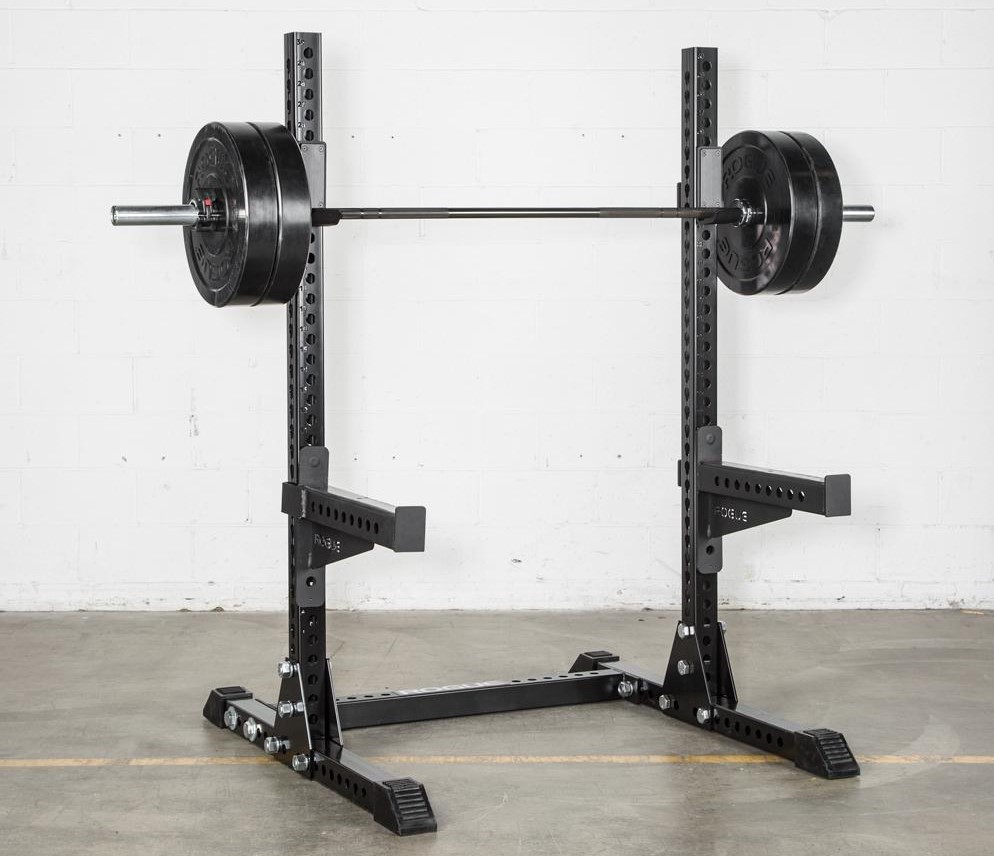
| Height | 72″ |
| Pull Up Bar | None |
| Weight | 122 lbs |
| Steel | 11 gauge 3″x3″ |
| Price | $415 + $195 Spotter Arms = $610 total |
Yep, I know, this kind of squat rack aint a power rack. But it will be more comfortable for users taller than about 5’9″ who would be banging their heads on the pull up bar of 6ft power racks.
If you get this squat rack, you’ll be in pretty good shape safety-wise. Not as safe as a power rack where you’re fully enclosed and the safety bars have the maximum amount of support. Of course, you also sacrifice the pull up bar.
With a squat rack like this, be sure to add the 24″ safety spotter arms shown in the options on the page! The whole reason I’m recommending this unit is because it has long safety arms that work good.
Besides the safety arms, you can add wheels to make it mobile, or brackets to bolt it down into concrete with.
If you browse Rogue’s site you’ll see the cheaper S-1 and more expensive SM-1. The S-1 is lighter and has shorter safety arms. You don’t save that much money. The SM-1 is the Monster version, as expensive as they could make it. The middle of the road SML-1 is the right choice here for most people.
The SML-1, with the spot arms, is higher priced than short power racks I went over above. It’s also a lot beefier, to help make up some safety and stability in lieu of being a full power rack. For what it is, the Rogue unit doesn’t have any flaws. If you really want to do pull ups, find another way to do it. Doing pull ups from a 6ft bar isn’t going to work for tall users anyway.
Let me know if you disagree with my assessments here, or if there is another rack I should include!

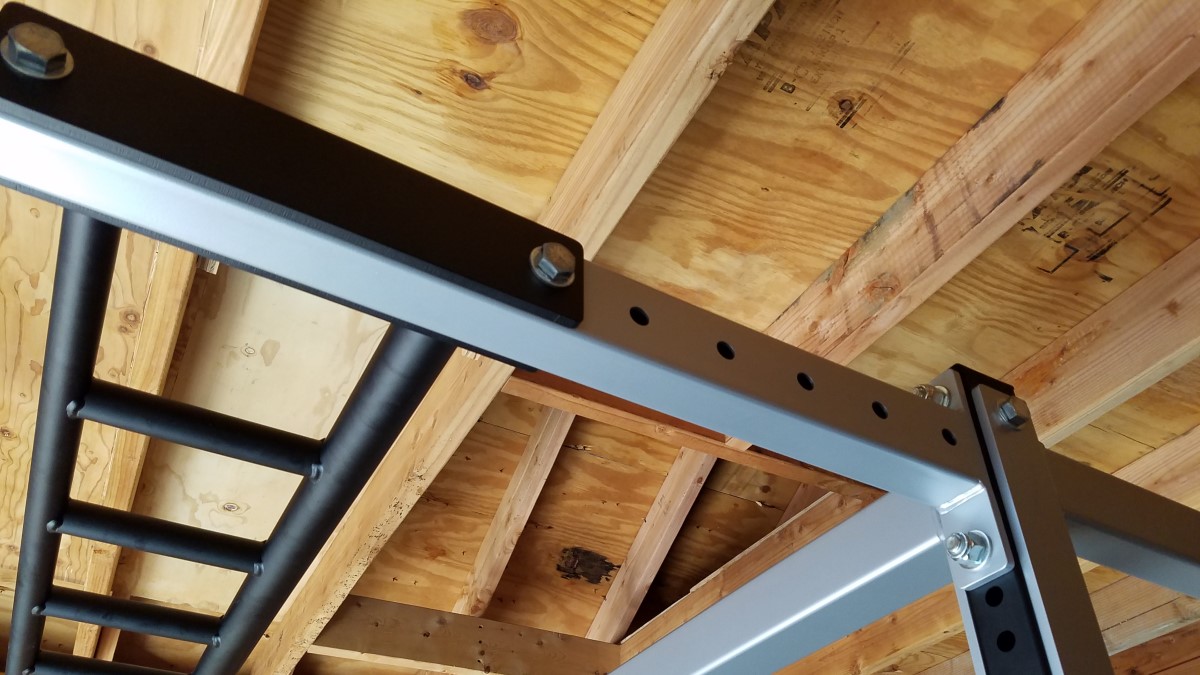
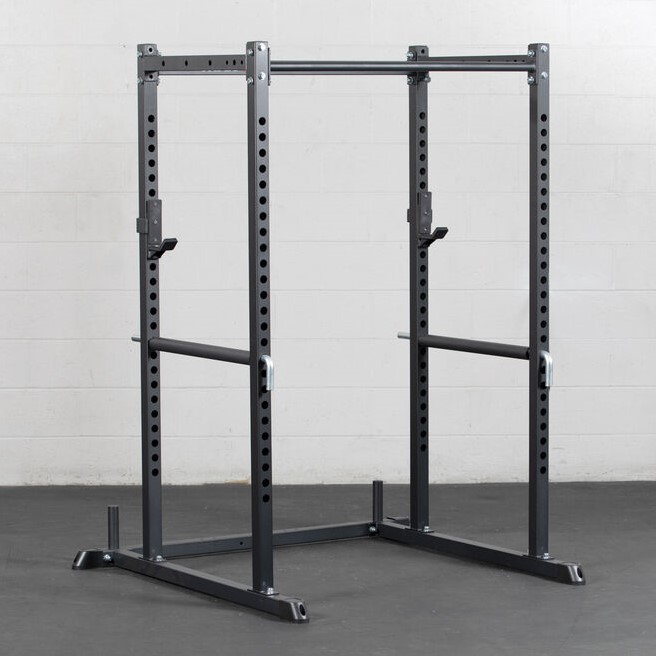
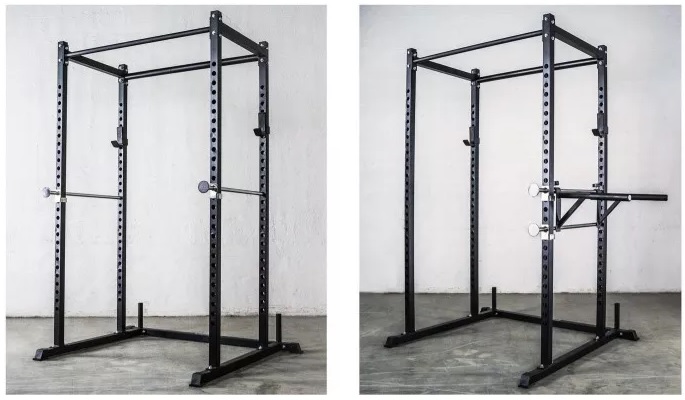
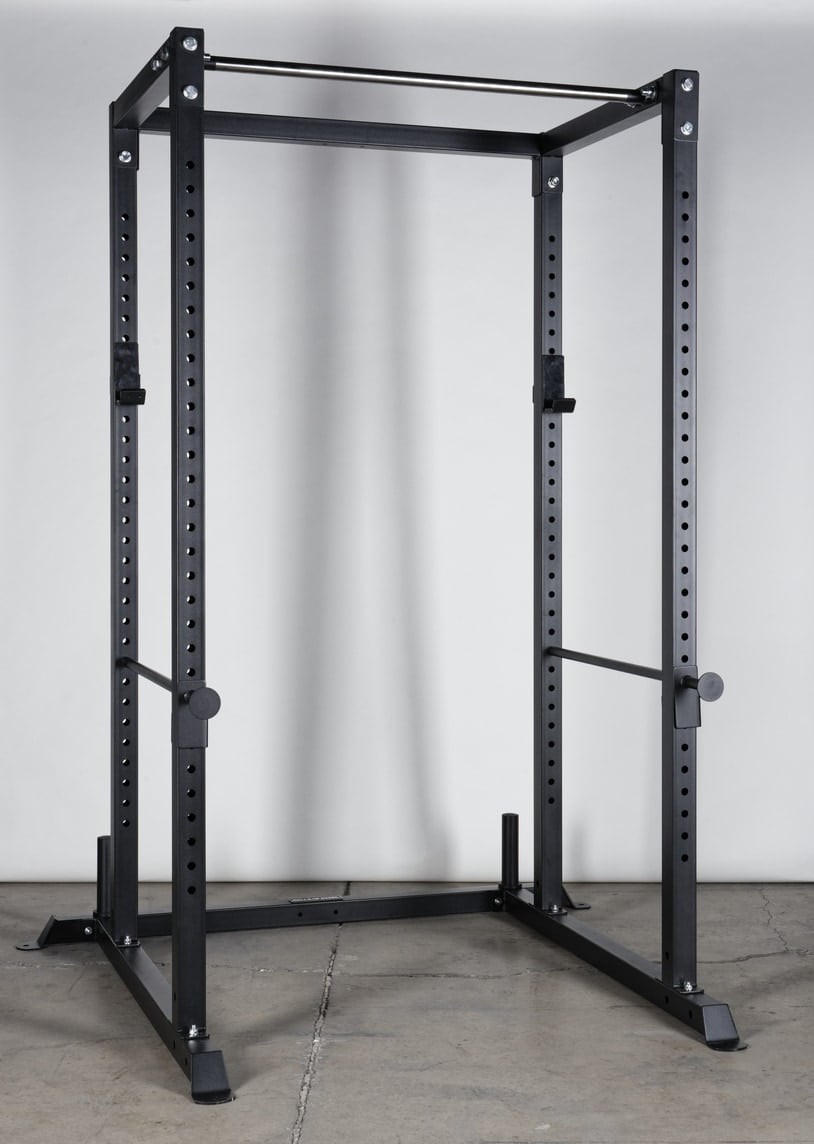
i have a small celing clearance of about 77 inches. are there any foldable wall mounted racks that would fit? or can i buy and parts and do it myself? i could get a stand alone but i dont want to take up so much floor space perturding.
I’m not aware of any folding wall mounted rack that short. You could buy one and have someone cut off the top of the uprights. The pull up bar being lower (and it’s needed for stability) would require you move the upper wall connectors underneath your J cups. Could work. Post a pic if you do it!
Yup my garage has low ceilings unfortunately so most power racks will not fit. What are your thoughts on the Hammer Strength Olympic rack? It is not cheap but I love the one that I used to use in the last gym I belonged to and lower than power rack but still American made quality.
https://www.lifefitness.com/en-us/catalog/strength-training/racks-rigs/hammer-strength/olympic-squat-rack
I was thinking of this or the Hammer Strength V Squat machine and a barbell on rubber mat for deadlift platform to do legs and a cable gym for upper body stuff with a few dumb bells.
Something like that is fine. I don’t know what they charge new (by quote only) but Freedom Fitness Equipment has a used one. https://freedomfitnessequipment.com/collections/racks/products/hammer-strength-olympic-squat-rack
Another option is the Rogue Fitness combo rack that has features for squat and bench press with safety spotter arms. It’s expensive but beefy
https://www.roguefitness.com/rogue-combo-rack
I’m recovering from bad left shoulder arthritis so I’d need to pick up a safety squat bar from them to do squats anyways.
Just pointing out that the X-2 was discontinued last fall. I have it. Works great. But it was discontinued and they are no longer stocking accessories that do not also fit other racks.
Ok, thanks! I’ll have to revise this article with one of their current racks.
Or the Abilica 024? I’m in Europe, so that might change things.
Hi!
I’m in the unfortunate position of being 6’7 and lifting in a garage that has a ceiling just under 87 inches. It’s not all doom and gloom though as I already have a great DIY system for pull ups, so I mainly want the power rack for squats and bench variations. I also think I have people around me who will help assemble it upright.
Any tips? The REP 1050 looked kinda promising for these circumstances. I’m not moving huge weight either, but I don’t want to destroy the rack on a failed 440 lb squat.
Given that you have a pull up bar, at your height, and in that kind of space, you would do good with an open-top squat rack. There are some fully enclosed ones safer than the Rogue SML-1, basically with most of the upper frame removed to give full headroom and overhead movement. The ones I’ve seen are on the expensive end like this, but this is the idea:
https://www.fitnessfactory.com/item/4311/smr1000/pro_clubline_multi_power_rack_by_body-solid/
This was a helpful post for getting my basement gym outfitted. A shortie rack isn’t a big deal if you’re a shortie person! I got the Titan T-2. I’m 5’2″, so I expect it’ll fit me and my low ceilings just right.
Excellent! I’m 6ft, so I’m sure I miss issues that shorter or smaller people run into with equipment. I know thinner bars and handles are handy for women, and a 45lb bar can be too much of a starting weight for some exercises. What other kinds of issues have you had?
Yep, I got a women’s 15 kg bar, which is perfect. I didn’t even know those were a thing! I can use the 20 kg bar for squats and deadlifts, but it’s awfully hard to bench, at least at first.
One solution is as follows. My RM 3 fits nicely in my basement between the floor joints. From the floor to the bottom of the joist is 87” and the shortest Rogue rack is 90”. Distance between the racks uprights is 30”. I anchored my rack to the floor so that the four 90” uprights straddle the joists. I lowered the two cross pieces several holes to get them to 87”.
There’s also this rack that comes in 6 feet or 7 feet!
https://bridgebuilt.com/collections/phoenix
Could be a potentially good rack for saving floor space too! I suspect that the extra parts in the folding feature adds some undesirable play to the stability of the rack when some weight is put on it, and that other companies haven’t done something like that with their similar heavy duty squat racks for that reason. I’ve seen things like that before in lighter racks. Looks nice in the pics though. I’ll be listening to hear if anyone tries it out!
Hey, on the Titan site for the t2 1050 it says the steel is 11 gauge – where did you get that it was 12 gauge? Curious. Love the review btw!
I had checked with Titan and for a while I said it was 11 gauge, but at some point I became convinced that it’s 12 gauge, due to not only the weight but I think also from someone who has the rack or better info. Unfortunately I can’t remember what that source was. If someone can measure the wall thickness with a caliper, that will settle it! I mean, assuming they never changed it.
Just found that their site lists it as 11 or 12 depending which place your looking at, haha. I’m not sure to go with the t2 short or PR 1050 (i know the Titan has thicker steel, but I honestly just like the powder coat and look of the rep one more). I might be overthinking this lol
Thanks for this. Wish I’d read it three months ago!
I recently got the Rogue SML-1 to accommodate the problem of low basement ceilings. It’s worked out great for squats and bench presses.
One thing I was a bit disappointed to learn, however, is that Rogue says it is not compatible with any of the dip stations which they sell. I’m not sure if this is because the connectors are incompatible, or because they judge the stand is not stable enough to support the off-center load.
I think you’re right that they don’t want to recommend it for stability reasons. Unlike some racks the SML-1 uprights don’t have much support. Otherwise the matador attachment will definitely fit and only uses one hole. I imagine if you mount it on the inside it might work? Might cause trouble. One way to find out!
It’s not cheap, but the Rogue Combo Rack is pretty awesome.
I looked it up. Wow, that is one expensive rack!
Any reason the Titan X-2 Short or the X-3 Short were not included on the list?
I think when I originally wrote this Titan only had the T-2 short. The X-2 and X-3 racks are much better. I’ll add them soon!
Thanks for the detailed reviews! Is there any downfall to putting the titan t-2 on 4x4s to raise it a little bit and then run lag bolts through it to secure it? I’m 6’ 1” so just a few inches would make this rack work for me.
I can’t think of any major problem with doing that. You would lose a little bit of foot room. Let me know how it goes!
I almost got talked into a short rack instead of the SML and I’m glad I read this article considering I’m 6’4″. I had a full rack at my old house but my new house is old. The only reason I’m even looking for a new rack is because all the gyms are closed but Rogue is back-ordered for months now.
Did Rogue say something specifically to you about how long racks or other things are backordered? All I know is everyone is sold out of all their most popular stuff now.
Does the SML-1 work for you at over six feet tall? Just ordered one and am worried it’s too small
Appreciate the post! Have you run into any good rack with lat tower attachment?
I have a structural support beam limiting me to max height of 82″, though there is approx 8″ more room “behind”, where the lat tower could go.
Striking out so far
The Titan X-2 Short would fit under that and has a lat attachment.
https://www.titan.fitness/racks/power-racks/x-2-series/x-2-series-power-rack-%7C-short-%7C-bolt-down-%7C-sku%3A-400303/400303.html
This is exactly what I was looking for in order to start Stronglifts 5×5 in a basement that is just 7 feet tall. The Rogue SML-1 with spotter arms looks ideal. Thank you.
I’m glad it helped! I think the Rogue SML-1 is the best rack you can get for the price when you’re dealing with a 7ft ceiling. A full power rack just gets in the way.
Noah, I am in the exact same spot. Doing 5×5 in the gym and now deciding to get a home gym due to Covid.
Hey, I’m 6’2. My basement is 81″ at the bottom of the joists. For the power rack I’m not interested and don’t care about pull ups or anything fancy, just good low bar squats as well as protected bench presses (and OHP and DL). I think the Rogue might not be a bad buy but as far as the Titan T-2 short rack, will the bar still be at my chest/peck level as I load up? My nipples are at about 56″ so that gives us 16 inches of play from where the last holes have to be from the top at 72″.
Yeah, with the J cups in the top hole you’ll have the bar at least that high.
Hi, David, this article was incredibly informative. I just had a question: I’m 6″4, would I hit my head while squatting in the Titan 2? I was under the impression that only when walking into the rack from the side is this an issue.
Also, I have a ceiling that is 6″10 high. I want to purchase the Titan X3, which is 82 inches (6″8) and while your article says it won’t fit because it must be tilted at an angle to get up, I called Titan just now and they say that the rack can indeed be built from top to bottom without flipping it.
Thanks!
I have a similar question-also a tall guy. Would be great if he could respond.
Hi Joshua and Ernie,
You’re going to bump your head. They aren’t made for tall people. You may need a rack with an open top like the Rogue squat stand.
Right, if you have a helper to hold things you can build it bottom to top in place instead of standing it up when done.